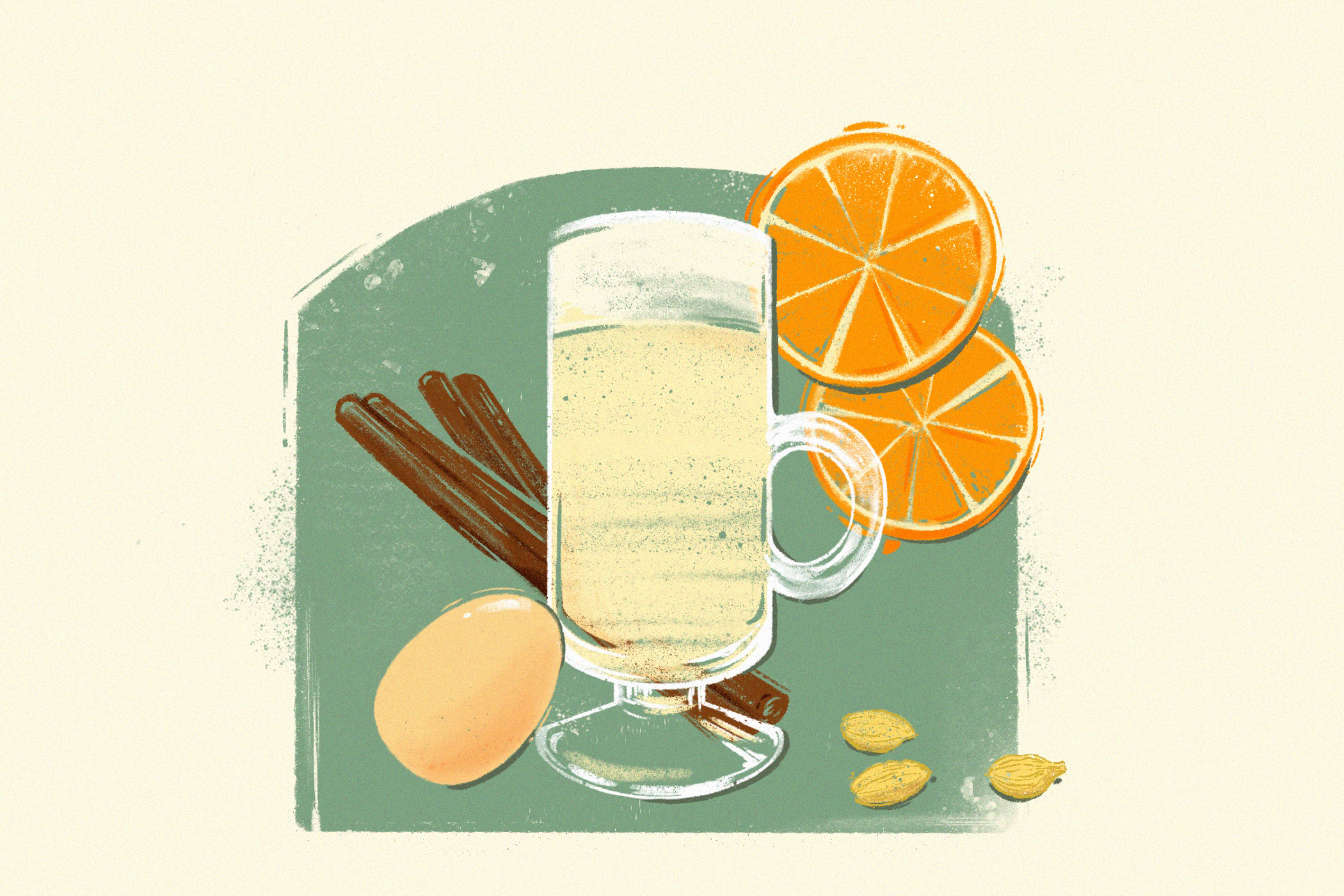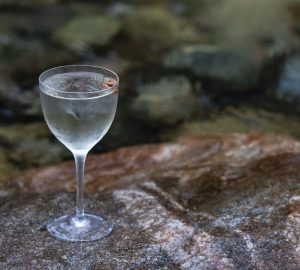They started with a red-hot poker, then added an egg, and now are back as a winter treat. By Paul Mathew.
These days flips very rarely make it on to cocktail lists, but that wasn’t always the way. Back in the 1600s, warming, rich, nourishing drinks that strengthened the imbiber were regularly to be found on tavern menus. These would be drunk as a supplement to food rather than necessarily for intoxicating effect, and were frequently made with heavy beers, with or without the addition of spirits to fortify them – drinks to keep you warm on cold nights.
One first reference to the flip as a drink comes from 1695, where it is used to describe a drink made with beer, rum and sugar. These were mixed together in a tankard, into which a red-hot iron was placed, causing the drink to heat through and bubble – the so-called “flipping”. There were many different recipes across Europe and the USA, with different spirits being added depending on what was available (rum was favoured in the USA where brandy was more expensive). Gradually other ingredients such as spices, egg, milk and flour were then added to improve the texture, flavour and nutritious aspects of the drink, and so by the time that Jerry Thomas included flips in the 1862 book How to Mix Drinks, they all include egg (and are all served hot). He is also very precise on the instructions, stating “The essential in ‘flips’ of all sorts is, to produce the smoothness by repeated pouring back and forward between two vessels, and beating up the eggs well in the first instance”. Rather than using a hot iron, these used hot water and were much like his famous Blue Blazer in preparation (and probably where he perfected the technique).
Flips were mixed in a tankard, into which a red-hot iron was placed, causing the drink to bubble – the so-called “flipping”
Cocktails evolve quickly however, and by the time the 1887 edition of Jerry Thomas’s book appears, flips are listed as either hot or cold recipes – presumably depending on the tastes of the drinker and the season. This edition of the book also has a section on Egg Nogg, made in a very similar way to the flip, but with the addition of milk or cream (except one recipe that uses apple cider). Here things get confusing though, as there are other references to flips with cream and milk, and indeed Egg Flips that are identical to the Egg Nogg described by Thomas. It seems that the two names are used quite interchangeably by this stage.
Going back to the origin of the name, the defining component of a flip should be the use of a hot poker or iron to “flip” the contents of the glass into a froth. Clearly this only really works if you happen to work in a bar that has an open fire (or a very accommodating kitchen). And consider that the health and safety inspectors might not take too kindly to red-hot metal being passed around, one can see where the drink might have diverged from the original recipe. There are bartenders that have used the technique in recent competitions though, and the results are interesting: the hot metal serves to scald and caramelise some of the ingredients, imparting a bitter, burned tang to the drink. It’s not to everyone’s taste, but can be replicated to some extent by adding a dash or two of bitters.
If heating the flip, make sure it is warm through but not hot enough to start cooking the egg. A coffee-machine milk steamer works well
These days we generally use the terms flip and nogg quite loosely, though an Egg Nogg is almost always served hot, while a flip is more generally shaken and cold. Both can contain cream or milk, along with pretty much any spirit or liqueur, spice and sweetener. There is even a pre-mixed egg liqueur, Advocaat, which follows a similar recipe, generally using brandy or neutral grain spirit, with versions from many of Europe’s traditional liqueur-makers. These can be a useful alternative ingredient should your bar frown upon using fresh raw eggs in cocktails.
With the colder days drawing in and customers favouring rich drinks again, now is a great time to get some flips going. Hot or cold, they really complement seasonal menus, and they look and smell great, enticing more customers to give them a try.
Giving the flip
- Flip (from A. William Schmidt’s The Flowing Bowl, 1892)
“One and a half quarts of beer are heated to boiling, with a stick of cinnamon, a small piece of ginger, two or three cloves and some lemon-peel; meanwhile mix the yolks of four eggs with a large wineglassful of rum or arrack, two or three tablespoonfuls of pulverised sugar, and a small spoonful of corn-starch; add this, while continually stirring, to the beer; pour it a few times from one vessel into another, strain through a sieve, and serve in cups.”
Modern version for one serving:
60ml Full-bodied rum
20ml Sugar syrup (1:1) (preferably Demerara sugar syrup)
1 Egg
A grate of cinnamon, fresh ginger, nutmeg and cloves
1 dash Orange bitters
Add all the ingredients into a mixing glass or tankard. Dry shake or throw to mix the ingredients, then warm with the steam nozzle of a coffee machine (or in a pan on a hot-plate). Throw or shake again to thoroughly mix. Serve in a cup or small tankard with a grate of nutmeg on the top.
- Lazy Man Flip
This was invented at Milk & Honey London in 2006, and combines the richness of port with the strength and complexity of calvados. Using port in cocktails helps to use open bottles so they remain fresh – the same applies to sherry and vermouth as well – they are all wine-based, so need to be refrigerated and used quite quickly to prevent excess oxidation (less important for sweeter, aged sherries).
45ml Ruby Port
25ml Calvados
25ml Heavy (double) cream
15ml Sugar syrup
1 Egg yolk
Break up the yolk (beat it to a smooth consistency if you have time), and then shake all the ingredients with ice; double strain into a sour or coupette glass and garnish with an orange twist and a grate of nutmeg.
Tips for Flips
Egg cocktails should be dry shaken (without ice), beaten or whisked before shaking with ice. This emulsifies the egg making the drink smooth rather than lumpy. Alternatively pour repeatedly back and forth between two containers (see Jerry Thomas’s advice).
A citrus twist, dash of bitters or spice garnish will mask any potentially unpleasant smell of egg on the surface of the drink, as well as adding that important bouquet to the cocktail.
Flips were originally made for social drinking in the same manner as punches, so they can be made in batches and served at the table, perhaps as a dessert with a ladle and small cups. They can even be set like a crème caramel if the quantity of egg is increased.
Any sweetener can be used to add the richness to a flip. Molasses, agave syrup, honey, flavoured sugar syrups or any liqueur will work well, but the quantity needs to be adjusted according to the level of sweetness in the product (measured in Degrees Brix [°Bx], or how many grams per litre of sugar the liquid contains).
If heating the flip, make sure it is warm through but not hot enough to start cooking the egg. A coffee-machine milk steamer works well, but you need to keep the liquid moving or it can scald and start to form lumps, which require straining.
As with all cocktails, keep it fresh – date eggs carefully and use well before their expiry date as they are used raw. Grate spices like nutmeg and cinnamon for each drink, and make sure the sugar syrups and dairy are all correctly stored in a refrigerator or chilled section of an ice well.








